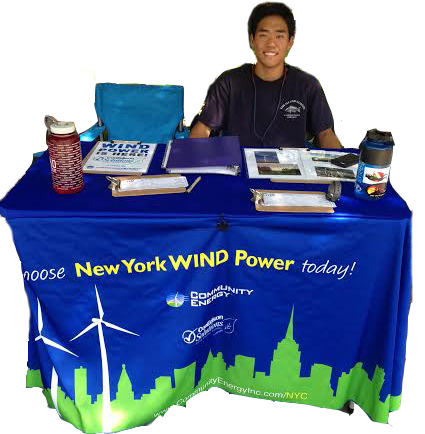It’s easy to let a day go by without appreciating things that deserve to be appreciated. Energy is one of them. If it weren’t for the energy created through the combustion of diesel oil in the engine of a shipping truck, you wouldn’t have had that apple this morning. If it weren’t for the electricity that ended up in your outlet, neither your phone nor your laptop would be charged. In fact, they wouldn’t exist in the first place. If it weren’t for energy… the list goes on. Today, the crucial energy industry is dominated by brown energy (energy from polluting sources). Fossil fuels, mainly coal and natural gas, supply nearly 2/3 of the United States’ electricity, while wind supplies a measly 4%. New York City alone boasts even more dismal figures. Most of New York’s energy utility company Con Edison’s electricity source consists of a mix of coal, natural gas and nuclear energy, leaving little room for renewables.
 This past summer I worked for Community Energy Inc., one of the companies that create renewable energy programs for Con Edison. My main task was to convince passersby in NYC to adopt Community Energy’s 100% wind program. By opting in, your electricity rates increase by 2.5 cents per kilowatt-hour, increasing your electricity bill around 9%. You end up writing a check for $65, as opposed to $60 (or $550, as opposed to $500, for larger energy consumers), but you’d be forcing Con Edison to supply that much more wind energy to the city’s electrical grid. Drastic reduction of carbon dioxide emissions, an end to the everlasting fracking controversies and less dependence on hazardous nuclear energy sources are some of the many positive impacts of opting in to renewable energy sources. No matter how big a financial commitment it may be, to me, wind seems the right choice to make. “This is too easy,” I told myself, anticipating the fat checks I’d receive from all the commissions. And so my boss Sam Carroll’s advice—“If you can sell wind in New York, you can sell anything”—didn’t make much sense until I actually tried setting up a table with an arsenal of pictures and brochures on the streets of Manhattan.
This past summer I worked for Community Energy Inc., one of the companies that create renewable energy programs for Con Edison. My main task was to convince passersby in NYC to adopt Community Energy’s 100% wind program. By opting in, your electricity rates increase by 2.5 cents per kilowatt-hour, increasing your electricity bill around 9%. You end up writing a check for $65, as opposed to $60 (or $550, as opposed to $500, for larger energy consumers), but you’d be forcing Con Edison to supply that much more wind energy to the city’s electrical grid. Drastic reduction of carbon dioxide emissions, an end to the everlasting fracking controversies and less dependence on hazardous nuclear energy sources are some of the many positive impacts of opting in to renewable energy sources. No matter how big a financial commitment it may be, to me, wind seems the right choice to make. “This is too easy,” I told myself, anticipating the fat checks I’d receive from all the commissions. And so my boss Sam Carroll’s advice—“If you can sell wind in New York, you can sell anything”—didn’t make much sense until I actually tried setting up a table with an arsenal of pictures and brochures on the streets of Manhattan.
For a high school environmentalist whose biggest achievement so far had been editing a promotion video for the eagerly awaited, campus-favorite Green Cup Challenge, this turned out to be a daunting task. The end result was not pretty. No matter how much I tried, people weren’t interested, and I sold the 100% wind program to a whopping total of 15 New York residents over the course of an entire month. Higher electricity bills were undoubtedly a factor. But the main problem was clear— everyday people just didn’t give a damn about green energy. Sadly, this is also the case at Deerfield, though it shouldn’t be. You don’t need to worry about your energy bills, so money isn’t a factor to begin with. The dining hall provides you with organic food and composts everything from your banana peels to your leftover burritos. Furthermore, Deerfield gives water bottles to all new students and has erected hydration stations all over campus. We have color- coordinated 80/20 posters that clearly define what qualifies as Trash, Compost, or Recyclables.
In the real world, living green can be inconvenient and costly. Here, where the administration does the hard part for us, all we have to do is just think, be aware, and make the little (good) choices. The connection might not seem immediate, but preservation of the things we love most about Deerfield—the beautiful campus, fresh air, the amazing view at the top of the Rock, the River in the spring—depends electricity increase by rates upon the choices we make today. Sometimes, our lives are busy, and it’s hard to appreciate things that deserve to be appreciated. But that certainly doesn’t mean it can’t be done.

